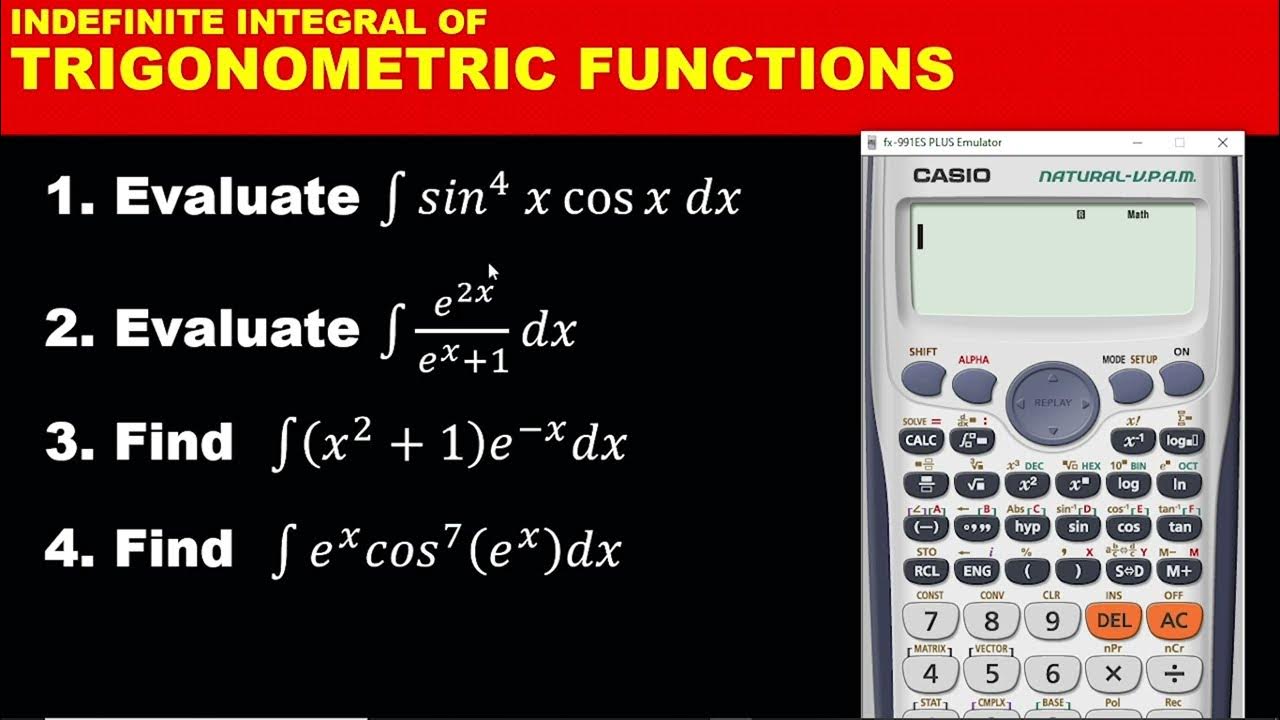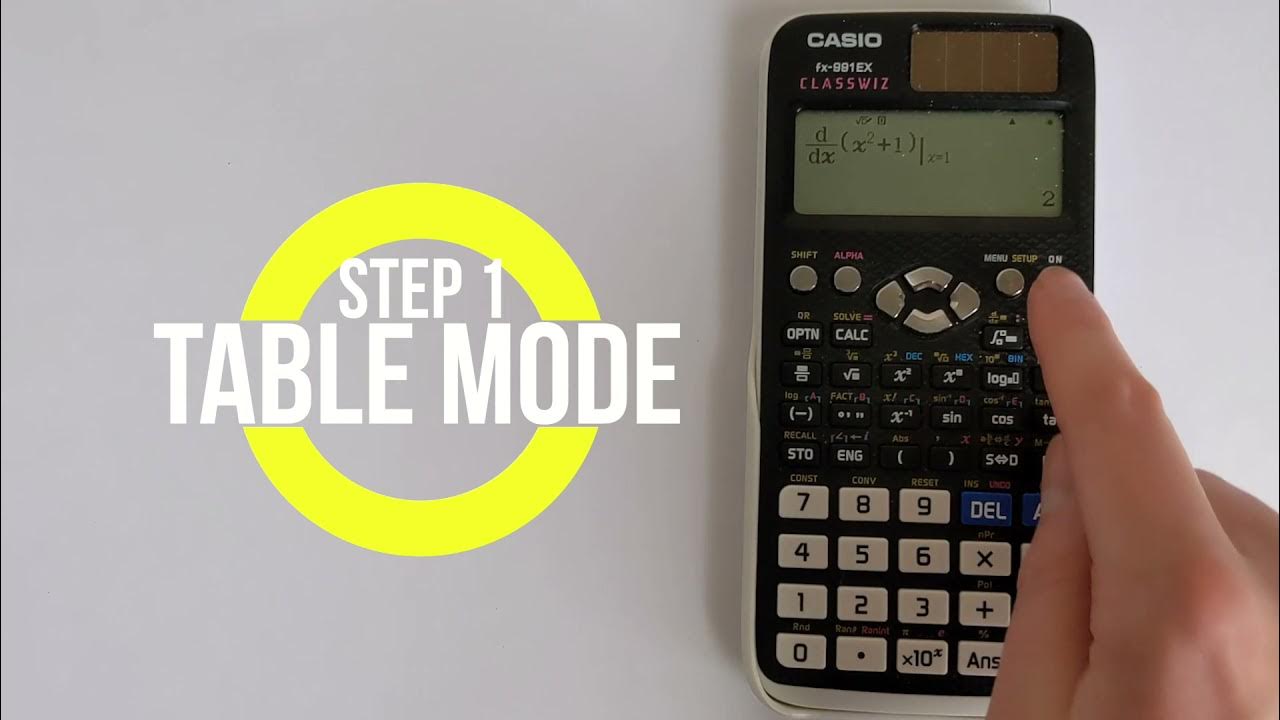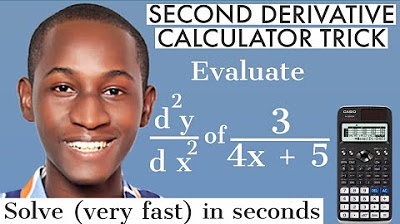How to solve differentiation using your calculator(Casio Cs- 991 ES plus)
TLDRThe video script is an instructional guide on how to use a calculator, specifically a Casio 991, to solve differentiation problems. The presenter demonstrates the process of differentiating various mathematical functions, such as polynomials and rational expressions, and emphasizes the importance of confirming answers for accuracy. The script outlines the steps for differentiating expressions like 3x^2 - 6x + 4, 7x^3, and more complex equations, showing how to input these into the calculator and use its functions to find derivatives. The presenter also explains how to use the calculator to check the correctness of the derivative by substituting specific values for x and taking limits. The video concludes by encouraging viewers to use calculators for verifying their work during exams and to subscribe for more tutorials on using calculators for engineering and mathematical problems.
Takeaways
- 😀 Understanding how to use a calculator for differentiation can make the process easier and faster.
- 📱 Demonstrated the steps to use a Casio 991 calculator for solving differentiation problems.
- 🔄 Showed the process of confirming answers using the calculator by substituting values and taking limits.
- 🧮 Emphasized the importance of confirming answers to ensure correctness in differentiation calculations.
- 🔢 Provided examples of differentiation problems and their solutions using both manual and calculator methods.
- 📝 Highlighted the application of mathematical principles such as the law of indices in differentiation.
- 🎓 Addressed the practical relevance of differentiation for students and engineers.
- 👨🏫 Presented a detailed tutorial style, including step-by-step instructions for solving differentiation problems.
- 💡 Offered insights on how to leverage calculators effectively in exam scenarios to verify answers.
- 📺 Encouraged viewers to subscribe for more tutorials on using calculators for mathematical computations.
Q & A
What is the main purpose of using a calculator for differentiation?
-The main purpose of using a calculator for differentiation is to make the process easier and faster, and to confirm the correctness of the answer.
How does the speaker confirm the answer to the differentiation of 3x^2 - 6x + 4?
-The speaker confirms the answer by substituting x with a value (in this case, 2) into the derivative expression 6x - 6 and checking if the result matches the expected value.
What calculator model is used in the script?
-The Casio 991 is the calculator model used in the script.
What is the derivative of 7x^3?
-The derivative of 7x^3 is 21x^2, as per the power rule of differentiation.
How does the speaker confirm the derivative of 7x^3 using the calculator?
-The speaker confirms the derivative by taking the limit as x tends to a specific value (in this case, 2) and checking if the calculator output matches the manually derived answer of 21x^2.
What is the process to find the derivative of a more complex function like 3x^3 + 2x^4 + 10x^2?
-The process involves applying the power rule of differentiation to each term separately, resulting in 9x^2 + 8x^3 + 20x.
How does the speaker use the calculator to confirm the derivative of the complex function?
-The speaker inputs the function into the calculator, sets the value of x to which the derivative is to be evaluated, and then checks if the calculator's output matches the expected derivative.
What is the derivative of the function 7 + 3x + 2x^2?
-The derivative of the function is 3 + 4x, applying the power rule and sum rule of differentiation.
How does the speaker demonstrate the confirmation of the derivative of 7 + 3x + 2x^2?
-The speaker uses the calculator to find the derivative and then takes the limit as x tends to a specific value (in this case, 2) to confirm the answer is correct.
What is the derivative of the function 3x^5 + 4/x^2?
-The derivative, after applying the power rule and the quotient rule, is 15x^4 - 8x^(-3).
How does the speaker confirm the derivative of 3x^5 + 4/x^2 using the calculator?
-The speaker inputs the derivative into the calculator and takes the limit as x tends to a very small value (接近0) to confirm the correctness of the derivative.
What is the importance of confirming the derivative using a calculator?
-Confirming the derivative using a calculator ensures the accuracy of the manually derived answer, which is crucial for exams or practical applications where precision is required.
Outlines
🧮 Using a Calculator for Differentiation
The speaker introduces the use of a calculator to simplify and speed up the process of differentiation. They demonstrate how to confirm answers using a Casio 991 calculator by solving the example of differentiating 3x^2 - 6x + 4. The process involves using the calculator's differentiation function and confirming the answer by substituting a value for x and checking the result against the manual solution of 6x - 6.
📚 Confirming Derivatives with a Calculator
The second paragraph focuses on confirming the derivative of 7x^3 using the calculator by taking the limit as x approaches a certain value, in this case, 2. The manual solution yields 21x^2, and the calculator is used to verify this by substituting x with 2 and checking the output. The process is repeated for a more complex equation involving 3x^3 + 2x^4 + 10x^2, with the calculator confirming the derivative as 9x^2 + 8x^3 + 20x.
🔢 Confirming Complex Derivatives
The third paragraph deals with confirming more complex derivatives using a calculator. The speaker shows how to find the derivative of 7 + 3x + 2x^2 and then confirms the result using the calculator by taking the limit as x approaches 2, which yields 11. The process is also demonstrated for the derivative of 3x^5 + 4/x^2, which is simplified using the laws of indices before differentiating and confirming with the calculator as x approaches a small value close to zero.
📈 Calculator's Utility in Exams
The final paragraph emphasizes the utility of a calculator during exams for confirming the correctness of derivatives. The speaker demonstrates the process using a calculator to find the derivative of an equation as x approaches a small value, yielding a result that confirms the manual solution. The speaker encourages viewers to subscribe for the next video, which will cover how to use the calculator for solving differentiation and other mathematical problems, highlighting the calculator's value for engineering students.
Mindmap
Keywords
💡Differentiation
💡Calculator
💡Derivative
💡Limit
💡
💡Function
💡Polynomial
💡Power
💡Law of Indices
💡Substitution
💡Simplify
💡Educational Content
Highlights
The video demonstrates how to use a calculator to solve differentiation problems, making the process easier and faster.
Confirming answers using a calculator provides assurance when solving differentiation questions.
The differentiation of 3x^2 - 6x + 4 is shown to be 6x - 6 using both manual and calculator methods.
A Casio 991 calculator is used to demonstrate the process of solving differentiation problems.
Substituting values into the derivative to confirm the answer is a key step in the process.
The derivative of 7x^3 is calculated to be 21x^2, confirmed using the calculator.
The video shows how to find the derivative of more complex functions, like 3x^3 + 2x^4 + 10x^2.
The calculator is used to confirm the derivative of 7 + 3x + 2x^2, which is 3 + 4x.
The law of indices is applied to simplify the differentiation of more complex expressions.
The derivative of 3x^5 + 4/x^2 is calculated and confirmed using the calculator.
The importance of taking limits as x approaches certain values to confirm the derivative is emphasized.
The video provides a step-by-step guide on how to use a calculator for differentiation, which can be beneficial for students during exams.
The calculator can be used to solve not only differentiation but also vectors for engineering students.
The presenter encourages viewers to subscribe for the next video, which will cover more on using the calculator for differentiation.
The video concludes with a reminder that while the Casio 991 is a bit expensive, the Casio 991es is a more affordable alternative.
The presenter thanks viewers for watching and invites them to watch the next video for further instruction.
Transcripts
Browse More Related Video

INTEGRATION PART 2: CALCULATOR TECHNIQUES ON INDEFINITE INTEGRATION OF TRIGONOMETRIC FUNCTIONS

DIFFERENTIATION PART 3: HOW TO DIFFERENTIATE TRIGONOMETRIC FUNCTION WITH THE CALCULATOR

AP Calculus BC 2003 Multiple Choice (calculator) - Questions 76 - 92

Casio FX-991EX Differentiation Tutorial: How to Find Derivatives on Your Casio Calculator

Limits of Trigonometric Functions

FAST STEPS TO SOLVE SECOND DERIVATIVE USING CALCULATOR: fx-991 ex | double differentiation
5.0 / 5 (0 votes)
Thanks for rating: